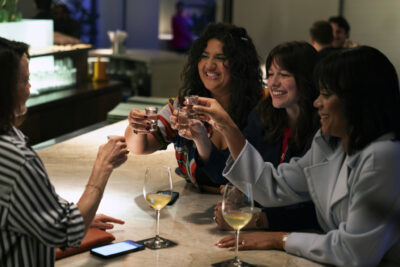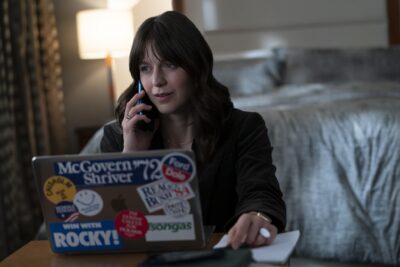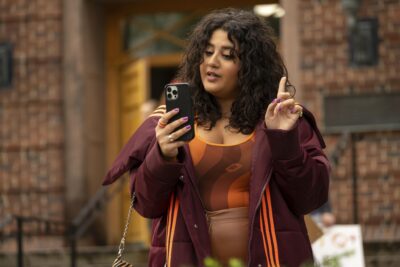In 2018, Amy Chozick released a memoir documenting the wild ride of being a journalist covering Hillary Clinton in both the 2008 and 2016 U.S. elections. Years later, she is bringing a chapter of Chasing Hillary to life as showrunner of the HBO series The Girls on the Bus, streaming now on Crave.
Although the TV series is primarily fiction, it is loosely based on Chozick’s experience on the campaign trail alongside reporters from various outlets all trying to get the scoop on the candidates running for the White House.
Starring Melissa Benoist, Carla Gugino, Christina Elmore, and Natasha Benham, the project brings a breath of fresh air to the world of politics by putting four driven and relatable women at the center of the story.
Sadie is a print journalist trying to rebuild her reputation, Grace is a veteran on the campaign trail searching for her next scoop, Kimberly is a reporter from a conservative news station hoping to get a promotion, and Lola is an influencer using TikTok to connect with young voters. Despite their contrasting personalities and reporting styles, they manage to bond in an environment that is often divisive.
Chozick not only wrote the source material that inspired The Girls on the Bus, but was also a hands-on collaborator in the making of the series.
In our conversation, she spoke about her transition from former girl on the bus to showrunner and executive producer, how the series brings an alternate vision to politics in the media, and why it was important to not shy away from real-life issues.
As a journalist and memoir writer, how was your experience diving into fiction for the first time?
It was super fun. I have always wanted to be a fiction writer. I studied poetry in college and moved to New York with the dream of being a poet, as one does in their 20s. Then I had to support myself, so I became a journalist and I loved it. I spent years covering Hillary, Obama, and Trump. Then I wrote my book, which is very much a memoir with my own personal voice. When I got the opportunity to write for television, I felt like my soul came alive. It was really fun and just felt natural.

The series balances politics and female friendships in such a light way. How was the process of coming up with a project that talks about political journalism without it being heavy?
American politics is very dark right now, and so is the American media. We really wanted it to be an escape. It’s not cynical. It’s not elitist. I really think it tries to invite anyone who’s ever had experiences as a woman balancing your personal life with ambition and female friendships. We think about politics as the backdrop and not the main reason you’re coming to the show. Hopefully you’re coming to the show for these relationships between the women and their own personal storylines.
Julie Plec and Greg Berlanti, known for successful TV shows like The Vampire Diaries and Love, Simon, also worked on this series. Do you remember what advice they gave you early on?
So much advice, like learning how to write on a budget. It’s a campaign show, so there’s big crowd scenes and there could be travel all over the country. You have to practically think about how we are going to make that consistently. A lot of authors are kind of wedded to what’s in their book and for me, it was the opposite. My partners always asked me: “What do you wish would have happened when you were covering politics?” We had this opportunity to rewrite history and to imagine the world as we want it to be, not as it really is.

In your memoir, you wrote about the hardships of maintaining objectivity while covering Hillary, which is similar to Sadie’s mixed feelings about covering Felicity Walker, a candidate with high chances of becoming the first female president of the U.S. How much of yourself did you put into the character and how much of it was fiction?
Sadie is the most similar to me. She writes for a fictional New York Times, and romanticizes a bygone era of journalism in the same way that I do. Melissa Benoist was amazing and did so much research and she shadowed some other female journalists as well. Sadie’s central journey is that we’re humans and that’s not to say that you can’t write a tough story and hold candidates accountable, even if you think they’d be a good president. Sadie starts off loving Felicity Walker and then she sees her as a human and it’s sort of heartbreaking, but it’s also liberating, because then she can just do the job.
Lola is such an interesting character because she represents a new era of journalism and influencers contributing to news. How did the character look at the beginning of the creative process and how did she change by the end of it?
When Julie and I first came up with the characters it was 2019 and we were actually drawn to this generation that experienced mass shootings and imagined who these kids would become when they grew up. Maybe they’d become an activist, and if they are an activist they are not working for a traditional news outlet. That’s the initial formation of Lola, but what’s interesting is that the media has changed so much since 2019. By the time we got closer to shooting in 2022 and 2023, the character had an incredibly influential TikTok feed. Most young voters are getting their information from TikTok—Lola became a much more realistic character to have on the bus.

The Girls on the Bus tackles a few heavy subjects, including abortion. What were some of the conversations in the writers’ room in making sure that the topics brought up on screen made sense to this day and age?
The characters all come from different generations, backgrounds, political beliefs, and types of journalism. So from the beginning, we wanted them to be as different as possible, still realistically forging a friendship and having those debates.
We had some core issues we really wanted to address. For me, the debates about journalism were really important. The debates about fake news and how you can be a journalist while half the country doesn’t believe anything you say anymore. That world was very important to me.
My showrunning partner, Rina Mimoun, has really spent her life trying to get abortion on television. As we were writing, we even had a map of the US in the writers’ room, and we had to figure out the campaign landing in a state that doesn’t ban abortion. Even after writing the show, the laws in the US were changing state by state so we had to move Sadie, and it was really chilling.
There are only a few episodes left before the finale of The Girls on the Bus lands on streaming. What can you hint about the end of Season 1?
Well, I wrote the finale and I put a lot of heart into it! It’s a big episode taking place in the Democratic National Convention, and everything we’ve seen so far in the season is coming to a head in the finale. Sadie is trying to work with the girls to break a huge story so it has a lot of adrenaline and it also brings the girls together. Each one has a satisfying and emotional cliffhanger.
The Girls on the Bus is currently streaming on Crave, with episodes coming out every Thursday until May 9.



 Follow Us On Instagram
Follow Us On Instagram
